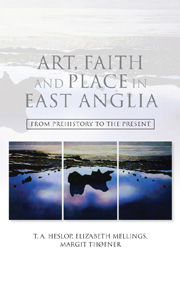Book contents
- Frontmatter
- Contents
- Acknowledgements
- List of illustrations
- CHAPTER 1 ‘Introduction: On Faith, Objects and Locality’
- CHAPTER 2 ‘But where is Norfolk?’
- CHAPTER 3 ‘Sacred Image and Regional Identity in Late-Prehistoric Norfolk’
- CHAPTER 4 ‘Piety from the Ploughsoil: Religion in Roman Norfolk through Recent Metal-Detector Finds’
- CHAPTER 5 ‘Paganism in Early-Anglo-Saxon East Anglia’
- CHAPTER 6 ‘Devotion, Pestilence and Conflict: The Medieval Wall Paintings of St Mary the Virgin, Lakenheath’
- CHAPTER 7 ‘Here Be Dragons: The Cult of St Margaret of Antioch and Strategies for Survival’
- CHAPTER 8 ‘The Medieval Jews of Norwich and their Legacy’
- CHAPTER 9 ‘Late-Medieval Glass-Painting in Norfolk: Developments in Iconography and Craft c.1250–1540’
- CHAPTER 10 ‘Graffiti and Devotion in Three Maritime Churches’
- CHAPTER 11 ‘Norfolk Wayside Crosses: Biographies of Landscape and Place’
- CHAPTER 12 ‘Landscapes of Faith and Politics in Early-Modern Norwich’
- CHAPTER 13 ‘Practice and Belief: Manifestations of Witchcraft, Magic and Paganism in East Anglia from the Seventeenth Century to the Present Day’
- CHAPTER 14 ‘Provinciality and the Victorians: Church Design in Nineteenth-Century East Anglia’
- CHAPTER 15 ‘Maharajah Duleep Singh, Elveden and Sikh Pilgrimage’
- CHAPTER 16 ‘Supernatural Folklore and the Popular Imagination: Re-reading Object and Locality in Mid-Nineteenth-Century Norfolk’
- CHAPTER 17 ‘Pro Patria Mori: Christian Rallies and War Memorials of Early-Twentieth-Century Norfolk’
- CHAPTER 18 ‘Pagans in Place, from Stonehenge to Seahenge: “Sacred” Archaeological Monuments and Artefacts in Britain’
- CHAPTER 19 ‘Art, Spirit and Ancient Places in Norfolk’
- CHAPTER 20 ‘Sacred Sites and Blessed Objects: Art and Religion in Contemporary Norfolk’
- Bibliography
- Index
CHAPTER 13 - ‘Practice and Belief: Manifestations of Witchcraft, Magic and Paganism in East Anglia from the Seventeenth Century to the Present Day’
Published online by Cambridge University Press: 05 April 2013
- Frontmatter
- Contents
- Acknowledgements
- List of illustrations
- CHAPTER 1 ‘Introduction: On Faith, Objects and Locality’
- CHAPTER 2 ‘But where is Norfolk?’
- CHAPTER 3 ‘Sacred Image and Regional Identity in Late-Prehistoric Norfolk’
- CHAPTER 4 ‘Piety from the Ploughsoil: Religion in Roman Norfolk through Recent Metal-Detector Finds’
- CHAPTER 5 ‘Paganism in Early-Anglo-Saxon East Anglia’
- CHAPTER 6 ‘Devotion, Pestilence and Conflict: The Medieval Wall Paintings of St Mary the Virgin, Lakenheath’
- CHAPTER 7 ‘Here Be Dragons: The Cult of St Margaret of Antioch and Strategies for Survival’
- CHAPTER 8 ‘The Medieval Jews of Norwich and their Legacy’
- CHAPTER 9 ‘Late-Medieval Glass-Painting in Norfolk: Developments in Iconography and Craft c.1250–1540’
- CHAPTER 10 ‘Graffiti and Devotion in Three Maritime Churches’
- CHAPTER 11 ‘Norfolk Wayside Crosses: Biographies of Landscape and Place’
- CHAPTER 12 ‘Landscapes of Faith and Politics in Early-Modern Norwich’
- CHAPTER 13 ‘Practice and Belief: Manifestations of Witchcraft, Magic and Paganism in East Anglia from the Seventeenth Century to the Present Day’
- CHAPTER 14 ‘Provinciality and the Victorians: Church Design in Nineteenth-Century East Anglia’
- CHAPTER 15 ‘Maharajah Duleep Singh, Elveden and Sikh Pilgrimage’
- CHAPTER 16 ‘Supernatural Folklore and the Popular Imagination: Re-reading Object and Locality in Mid-Nineteenth-Century Norfolk’
- CHAPTER 17 ‘Pro Patria Mori: Christian Rallies and War Memorials of Early-Twentieth-Century Norfolk’
- CHAPTER 18 ‘Pagans in Place, from Stonehenge to Seahenge: “Sacred” Archaeological Monuments and Artefacts in Britain’
- CHAPTER 19 ‘Art, Spirit and Ancient Places in Norfolk’
- CHAPTER 20 ‘Sacred Sites and Blessed Objects: Art and Religion in Contemporary Norfolk’
- Bibliography
- Index
Summary
INTRODUCTION
What are the links between the supposed beliefs and practices of those denounced as ‘witches’ in East Anglia in the seventeenth century and later manifestations of folk witchcraft and ‘cunning craft’? How do these historical phenomena relate to the beliefs and practices of the growing communities of Pagans in the region over the last fifty years and into the present? The present chapter explores these questions as well as distinctions between past and present definitions of magic and their fluctuating relationship with religion.
MATTHEW HOPKINS AND THE EAST ANGLIAN WITCH TRIALS
Historically, East Anglia has been particularly associated with witchcraft, mainly due to the activities of Matthew Hopkins (c.1620–47). Between 1644 and 1647, he conducted ruthlessly systematic witch-hunts, focusing on Essex, Suffolk and Norfolk. Hopkins, son of a Puritan clergyman, was born in Suffolk, probably at Great Wenham, although, as is clear from the work of Malcolm Gaskill, whose book Witchfinders constitutes the most up-to-date detailed study of Hopkins and his work, relatively little is known about his life.
During his short career, Hopkins was responsible for condemning an estimated three hundred witches to death and imprisoning many more. If he was to be believed, witches lurked around every corner, conspiring with the Devil to undermine society. There were more witch-trials in East Anglia than in any other region of England and the majority of these took place under Hopkins's aegis.
- Type
- Chapter
- Information
- Art, Faith and Place in East AngliaFrom Prehistory to the Present, pp. 194 - 208Publisher: Boydell & BrewerPrint publication year: 2012



